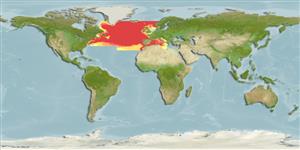Environment: milieu / climate zone / depth range / distribution range
Ecologie
marien bathypelagisch; oceanodroom; diepte 50 - 1032 m (Ref. 56504), usually 200 - 600 m (Ref. 35388). Deep-water; 65°N - 30°N, 77°W - 21°E
Atlantic Ocean: restricted to the North Atlantic and adjacent seas.
Grootte / Gewicht / Leeftijd
Maturity: Lm ? range ? - ? cm
Max length : 50.0 cm SL mannelijk / geslacht onbekend; (Ref. 35388)
Depth range from 50-1000 m (ref. 04473) and up to 1032 m in the eastern Ionian Sea (Ref. 56504). Epipelagic to bathypelagic (Ref. 58426); also mesopelagic (Ref. 5951). Feeds on fishes, crustaceans and occasionally planktonic organisms (Ref. 5759). Spawns from March to September, larvae near the surface (Ref. 35388).
Levenscyclus en paargedrag
Maturiteit | Voortplanting | Paaien | Eieren | Fecunditeit | Larven
Larvae are found near the surface.
Post, A., 1990. Paralepididae. p. 373-384. In J.C. Quero, J.C. Hureau, C. Karrer, A. Post and L. Saldanha (eds.) Check-list of the fishes of the eastern tropical Atlantic (CLOFETA). JNICT, Lisbon; SEI, Paris; and UNESCO, Paris. Vol. 1. (Ref. 4473)
Status op de Rode Lijst van het IUCN (Ref. 130435: Version 2024-1)
Gevaar voor de mens
Harmless
Gebruik door de mens
Visserij: van geen belang
Tools
Can't connect to MySQL database fbquizv2. Errorcode: Too many connections
